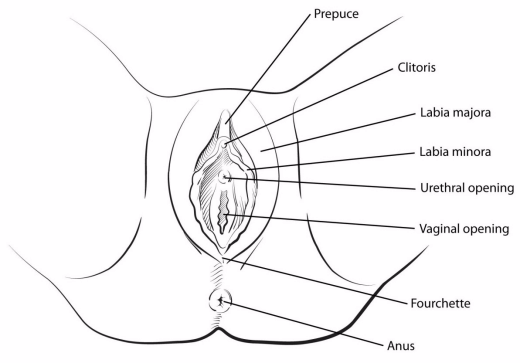What Is Vulvar Cancer?
The vulva is the outer part of the female genitals. The vulva includes the opening of the vagina (sometimes called the vestibule), the labia majora (outer lips), the labia minora (inner lips), and the clitoris.

Around the opening of the vagina, there are 2 sets of skin folds. The inner set, called the labia minora, are small and hairless. The outer set, the labia majora, are larger, with hair on the outer surface. (Labia is Latin for lips.) The inner and outer labia meet, protecting the vaginal opening and, just above it, the opening of the urethra (the short tube that carries urine from the bladder). The Bartholin glands are found just inside the opening of the vagina -- one on each side. These glands produce a mucus-like fluid that acts as a lubricant during sex.
At the front of the vagina, the labia minora meet to form a fold or small hood of skin called the prepuce. The clitoris is beneath the prepuce. The clitoris is an approximately ¾-inch structure of highly sensitive tissue that becomes swollen with blood during sexual stimulation. The labia minora also meet at a place just beneath the vaginal opening, at the fourchette. Beyond the fourchette is the anus, the opening to the rectum. This is where stool comes out of the body. The space between the vagina and the anus is called the perineum.
Cancer of the vulva (also known as vulvar cancer) most often affects the inner edges of the labia majora or the labia minora. It starts in the clitoris or in the Bartholin glands less often.
Types of vulvar cancer
Cancer starts when cells in the body begin to grow out of control. Cells in nearly any part of the body can become cancer, and can spread to other areas of the body. To learn more about how cancers start and spread, see What Is Cancer?
Squamous cell carcinomas
Most cancers of the vulva are squamous cell carcinomas. This type of cancer starts in squamous cells, the main type of skin cells. There are several subtypes of squamous cell carcinoma:
- The keratinizing type is most common. It usually develops in older women and is not linked to infection with human papilloma virus (HPV) (HPV is discussed in Risk Factors for Vulvar Cancer).
- Basaloid and warty types are less common. These are the kinds more often found in younger women with HPV infections.
- Verrucous carcinoma is an uncommon subtype that's important to recognize because it's slow-growing and tends to have a good prognosis (outlook). This cancer looks like a large wart and a biopsy is needed to be sure it's not a benign (non-cancer) growth.
Adenocarcinoma
Cancer that starts in gland cells is called adenocarcinoma. About 8 of every 100 vulvar cancers are adenocarcinomas. Vulvar adenocarcinomas most often start in cells of the Bartholin glands. These glands are found just inside the opening of the vagina. A Bartholin gland cancer is easily mistaken for a cyst (build-up of fluid in the gland), so it's common to take awhile to get an accurate diagnosis. Most Bartholin gland cancers are adenocarcinomas. Adenocarcinomas can also form in the sweat glands of the vulvar skin.
Paget disease of the vulva is a condition in which adenocarcinoma cells are found in the top layer of the vulvar skin. Up to 25% of patients with vulvar Paget disease also have an invasive vulvar adenocarcinoma (in a Bartholin gland or sweat gland). In the remaining patients, the cancer cells are found only in the skin's top layer and have not grown into the tissues below.
Melanoma
Melanomas are cancers that start in the pigment-producing cells that give skin color. They are much more common on sun-exposed areas of the skin, but can start in other areas, such as the vulva. Vulvar melanomas are rare, making up about 6 of every 100 vulvar cancers.
More information on this can be found in Melanoma Skin Cancer.
Sarcoma
A sarcoma is a cancer that starts in the cells of bones, muscles, or connective tissue. Less than 2 of every 100 vulvar cancers are sarcomas. Unlike other cancers of the vulva, vulvar sarcomas can occur in females at any age, including in childhood.
Basal cell carcinoma
Basal cell carcinoma, the most common type of skin cancer, is more often found on sun-exposed areas of the skin. It occurs very rarely on the vulva. For more information on this type of cancer, see Basal and Squamous Cell Skin Cancer.
- Written by
- References

The American Cancer Society medical and editorial content team
Our team is made up of doctors and oncology certified nurses with deep knowledge of cancer care as well as editors and translators with extensive experience in medical writing.
Last Revised: January 16, 2018
American Cancer Society medical information is copyrighted material. For reprint requests, please see our Content Usage Policy.
American Cancer Society Emails
Sign up to stay up-to-date with news, valuable information, and ways to get involved with the American Cancer Society.


